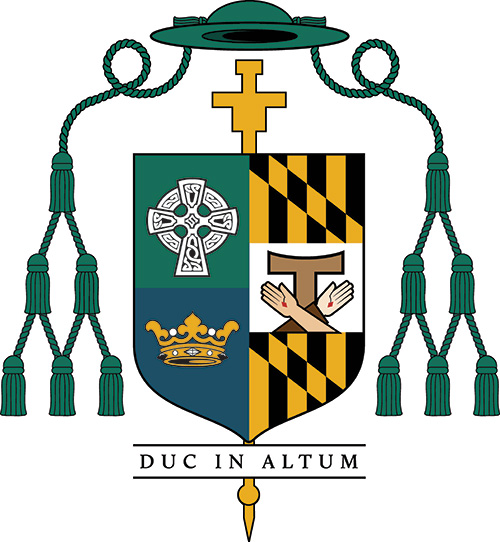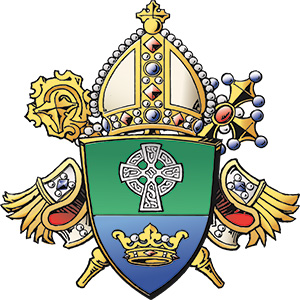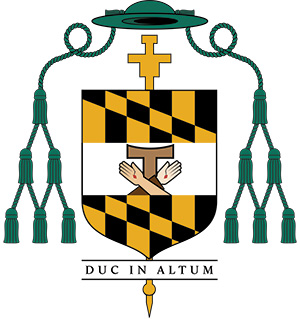 Bishop Michael Martin has chosen simple, powerful symbols of his faith and personal history for his episcopal coat of arms. He also enlisted the help of a former student to design it.
Bishop Michael Martin has chosen simple, powerful symbols of his faith and personal history for his episcopal coat of arms. He also enlisted the help of a former student to design it.
Brian Taberski was one of then-Father Martin’s theology students at St. Francis High School in Athol Springs, New York. Thirty years later, he found himself designing the coat of arms that would symbolize his former teacher’s new status as the fifth Bishop of Charlotte.
Taberski developed an interest in heraldry, the system of creating coats of arms, while he was a student at St. Francis. He turned it into a personal passion – a way of expressing his faith and love of history, and a way of serving the Church. He has designed coats of arms for two other bishops. One of them was Archbishop Gregory Hartmayer of Atlanta, also a Franciscan, when he became bishop of the Diocese of Savannah prior to his move to Atlanta. Archbishop Hartmayer also served on the faculty at St. Francis when Taberski was a student.
Taberski says then-Father Martin had a profound impact on him in high school – both as a teacher and as a priest. The insights on Catholicism he learned from Father Martin led him to teach theology for a while later in life, he said, and during the lockdowns of COVID-19 he found a spiritual lifeline in watching livestreams of Masses that Father Martin celebrated at Duke University.
“When you hear him preach, you see his pastoral skill as well as his intellect,” Taberski says. “This is a man whose intellect is so sharp that he can sit with anyone and explain things about the Church to them in exactly the way it needs to be said so they can understand.”
Taberski kept in touch with his former teacher over the years, and offered to create his coat of arms when he was named to lead the Charlotte diocese.
“Bishop Martin was very clear about wanting to represent who he is – a Franciscan and a native son of Maryland,” Taberski says. “He wanted something that was easily identifiable and not complicated.”
Coats of arms originated in 11th-century Europe and were originally used by warriors to identify their comrades on the battlefield. Over the centuries, they have become official symbols of families, rulers and Church leaders. A bishop’s coat of arms is used on documents, letterheads and other official items as a symbol of his office.
At the top of Bishop Martin’s coat of arms is a green galero, a broad-brimmed hat once worn by clergy that now designates their rank. On either side are six green tassels called “houppes” which also signify the rank of a bishop in the Church.
To the viewer’s right is the Franciscan coat of arms. Featuring the traditional Franciscan Tau cross with two arms crossing one another, it is rich in symbolism. The two arms, one Christ’s and the other St. Francis of Assisi’s, both bear the stigmata. They symbolize God’s love and Francis’s loving response to the Word made incarnate, Taberski explained. It is an image found throughout the ministries, friaries, missions and sites served by the Franciscan order.
On the right side of the shield, the top (known as the “chief”) and the bottom (the “base”) feature references to George Calvert and his son Cecil Calvert – the first and second barons of Baltimore. The Calverts were among the first Catholics to arrive in colonial America. They established the then Province of Maryland as a safe place for English Catholics to emigrate to since they were no longer able to freely practice their faith at home. In the coat of arms, the use of six vertical stripes – alternately gold and black, with the diagonal stripe in color – recalls Bishop Martin’s hometown of Baltimore.
To the viewer’s left are two symbols of the Diocese of Charlotte. On the top is a Celtic cross symbolizing St. Patrick, patron of the diocesan cathedral. Below it, a crown symbolizes Queen Charlotte, consort of King George III of England, for whom the city of Charlotte was named.
The coat of arms also includes Bishop Martin’s personal motto, “Duc in altum,” which means “put out into the deep,” and are the words Jesus spoke to Peter in the Gospel of Luke (5:4).
Behind the shield is a gold San Damiano cross as the processional cross, a symbol of the bishop’s office. This particular style of cross is significant to Franciscans because the order’s movement began when St. Francis heard Jesus tell him from the cross in the chapel of San Damiano in Italy: “Francis, go rebuild my Church for it is falling to ruins.” At first, St. Francis thought it was a literal command to rebuild the chapel. Soon after, he realized it was a call to a greater mission: creating an order that would transform the life of the Church worldwide.
Taberski says it has been an honor to design the coat of arms for a man whose ministry has had such a profound impact on his life.
“My first thought as the news broke that he had been named bishop was that the people of Charlotte will get to experience one of the most pastoral priests I’ve ever encountered,” he says.
“You have received first and foremost a pastor and a shepherd who understands that everything we do in the Church is for the salvation of souls.”
Impalement

 Impalement is a heraldic practice in which two coats of arms are combined in one shield to denote a union.
Impalement is a heraldic practice in which two coats of arms are combined in one shield to denote a union.
The impaled shield is bisected in pale – that is, by a vertical line – with each half of the shield displaying one coat of arms.
For Bishop Martin, his personal Coat of Arms (right) is impaled, or combined, with the Arms of the Diocese of Charlotte (left), to form his official Coat of Arms as the Fifth Bishop of Charlotte (top).


